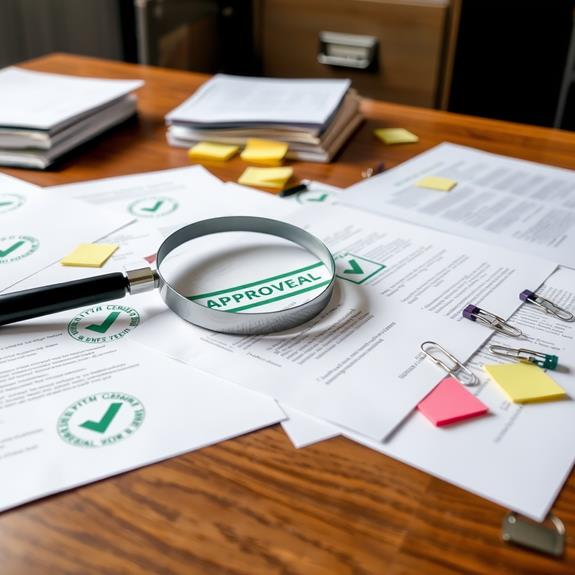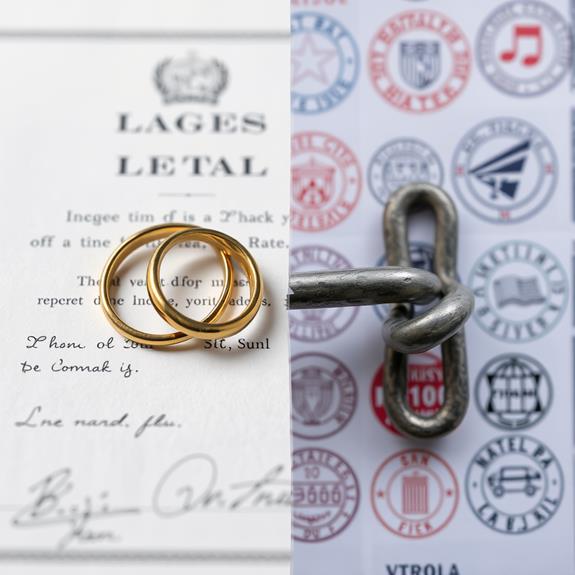To remove conditional residence, you'll need to file Form I-751 within 90 days before your two-year Green Card expires. Gather evidence of your genuine marriage, including joint financial documents, shared living arrangements, and photos. Submit the form with supporting materials to prove your relationship is ongoing. If divorced or facing hardship, you may qualify for a waiver. Be prepared for a potential USCIS interview. The process can take 12-18 months, so start early and stay organized. Legal assistance can be valuable, especially in complex cases. Understanding the requirements and following guidelines closely will increase your chances of success. Explore further to master each step of this critical process.
Understanding Conditional Residence

Two key things you need to know about conditional residence: it's temporary and it comes with strings attached. This status is typically granted to individuals who obtain permanent residence through marriage to a U.S. citizen or permanent resident. The conditional residence basics include a two-year validity period, during which you must prove that your marriage is genuine and ongoing. Immigration attorneys can provide expert guidance and support throughout this process, helping you navigate complex regulations and requirements.
Understanding the impact on immigration is vital. As a conditional resident, you have most of the same rights as a permanent resident, but your status isn't guaranteed. You'll need to file a petition to remove conditions within 90 days before your conditional residence expires. Failing to do so can lead to the loss of your status and potential deportation.
During your conditional residence period, you can work, travel, and live in the U.S. However, you must maintain your residence and avoid extended absences. It's important to gather evidence of your shared life with your spouse, such as joint financial records and photographs. This documentation will be essential when you apply to remove conditions and secure your permanent resident status.
Eligibility for Condition Removal
To qualify for condition removal, you'll need to meet specific criteria set by U.S. Citizenship and Immigration Services. You must demonstrate that your marriage is genuine and ongoing, or if divorced, that you entered the marriage in good faith. The immigration officials will carefully scrutinize your application for evidence of a legitimate marital relationship. Additionally, you'll have to submit the required forms, supporting documents, and fees before your conditional residency expires.
Qualifying for Condition Removal
In order to qualify for condition removal, you must meet specific eligibility requirements set by U.S. Citizenship and Immigration Services (USCIS). Many conditional residence misconceptions exist, so it's vital to understand the exact criteria. You'll need to prove that your marriage is genuine and ongoing, or if divorced, that you entered the marriage in good faith. Additionally, you must demonstrate that you haven't committed any crimes or violated immigration laws. Similar to citizenship through marriage, continuous residence and physical presence in the U.S. are important factors in the condition removal process.
Successful application strategies include gathering strong evidence to support your case. This may involve joint financial records, shared lease agreements, and photos documenting your life together. It's important to file Form I-751 within the 90-day period before your conditional residence expires. Make sure to include all required documents and fees with your application. If you can't file jointly with your spouse, you may be eligible for a waiver under certain circumstances. Be prepared to attend an interview with USCIS, where an officer will assess the validity of your marriage. By thoroughly understanding the requirements and preparing a detailed application, you'll increase your chances of successfully removing your conditional status.
Meeting Application Requirements
Several key requirements must be met to be eligible for condition removal. First, you must file Form I-751 within the 90-day period before your conditional residence expires. This timing is vital, so mark your calendar and start preparing early. You'll need to prove that you entered into a good faith marriage, which wasn't solely for immigration benefits. Gather evidence like joint bank accounts, shared leases, and photos together.
If you're no longer with your spouse, don't worry. You can still apply if you meet certain criteria, such as divorce, extreme hardship, or abuse. In these cases, you may file at any time before your status expires. One of the most important application tips is to include all required documents. Missing paperwork can lead to delays or denials.
Pay attention to requirement nuances. For example, you must have maintained residence in the U.S. continuously since getting conditional status. Brief trips abroad are usually okay, but extended absences might cause issues. Also, confirm you're current on any immigration-related fees or taxes. Following these guidelines carefully will increase your chances of a successful application.
Required Documentation

When you're ready to remove conditional residence, gathering the right paperwork is essential. The U.S. Citizenship and Immigration Services (USCIS) requires specific documentation types to process your application. You'll need to submit Form I-751, Petition to Remove Conditions on Residence, along with supporting documents that prove your marriage is genuine.
Documentation organization is vital for a smooth process. Start by collecting evidence of your shared life, such as joint bank statements, lease agreements, and utility bills. Include photos of you and your spouse together, especially at family events or on vacations. Gather affidavits from friends and family who can attest to the authenticity of your relationship. Make sure to include copies of your birth certificates, marriage certificate, and any children's birth certificates if applicable.
You'll also need to provide copies of your green card, passport, and driver's license. If you've changed your name, include documentation of the legal name change. Organize these documents chronologically and label them clearly. Create a cover letter that lists all the enclosed items. This attention to detail will help USCIS process your application more efficiently and increase your chances of success.
Filing Form I-751
When filing Form I-751, you'll need to gather specific documents to support your case. It's vital to review the required documentation checklist carefully to guarantee you've included all necessary items. Remember to take into account the filing deadline, as submitting your application on time is essential for maintaining your legal status in the United States.
Required Documentation Checklist
Preparedness is key when filing Form I-751 to remove conditional residence. To guarantee a smooth application process, it's vital to gather all necessary documents before submission. This checklist will help you navigate the requirements and boost your chances of success in removing your conditional status.
First, you'll need to provide proof of your ongoing marriage. This can include joint bank statements, shared lease agreements, or utility bills in both names. Photos of you and your spouse together, especially at family events or holidays, are also valuable. Don't forget to include birth certificates of any children born during your marriage.
Next, gather evidence of your shared financial responsibilities. This might include joint tax returns, shared credit card statements, or documentation of joint property ownership. You should also collect affidavits from friends and family who can attest to the authenticity of your marriage.
Lastly, make sure you have copies of your green card, passport, and marriage certificate. By following these application tips and thoroughly preparing your documentation, you'll be well-equipped to remove your conditional status.
Filing Deadline Considerations
Timing is essential when filing Form I-751 to remove your conditional residence status. You must submit this form within the 90-day period before your conditional Green Card expires. It's vital to mark your calendar and set reminders to avoid missing this critical deadline.
One of the most effective filing strategies is to gather your documents well in advance. This approach gives you ample time to collect all necessary evidence and complete the form accurately. If you're unsure about the exact expiration date of your conditional residence, check your Green Card or consult with an immigration attorney.
Remember, USCIS may accept late filings in certain circumstances, such as if you can demonstrate good cause for the delay. However, it's always best to file on time to avoid potential complications. If you're unable to file jointly with your spouse, you may need to request a waiver, which could affect your filing timeline.
To stay on track, consider setting up deadline reminders on your phone or computer. You can also create a checklist of required documents and mark off items as you gather them.
Joint Filing vs. Waiver Requests

For conditional residents seeking to remove their status, two primary options exist: joint filing with a spouse or submitting a waiver request. Joint filing benefits include a simpler process and a higher likelihood of approval. When you file jointly, you're demonstrating that your marriage is genuine and ongoing. This option requires both spouses to submit the petition together, providing evidence of your shared life.
Waiver request considerations come into play when joint filing isn't possible. You might need a waiver if you're divorced, separated, or facing domestic violence. Each waiver type has specific requirements. For instance, if you're filing due to divorce, you'll need to prove the marriage was entered in good faith. In cases of abuse, you'll need to provide evidence of the mistreatment.
The choice between joint filing and waiver requests depends on your unique situation. Joint filing is often preferred when possible, as it's generally smoother. However, waivers exist to protect those in difficult circumstances. Carefully assess your eligibility for each option before proceeding. Remember, accurate documentation and timely submission are essential for either path.
Common Challenges and Solutions
You may face several challenges when removing conditional residence. Common issues include difficulties in gathering necessary documentation, overcoming language barriers, and providing sufficient proof of your relationship. Understanding these challenges and preparing for them can help you navigate the process more smoothly and increase your chances of a successful outcome.
Documentation Gathering Difficulties
Gathering documentation for removing conditional residence can be an intimidating task. Many applicants struggle with locating, organizing, and presenting the required evidence. To overcome these challenges, consider implementing effective documentation strategies and organization tips.
Here are four key steps to help you navigate the documentation process:
- Create a checklist of required documents
- Start collecting evidence early and continuously
- Organize documents chronologically or by category
- Make copies of all important papers and store them safely
Begin by researching the specific requirements for your case. Understand that you'll need to provide evidence of a bona fide marriage, such as joint financial records, shared property leases, and photographs together. If you're having trouble obtaining certain documents, don't panic. Focus on gathering as much evidence as possible from various sources. Keep detailed records of your attempts to collect documentation, as this can demonstrate your good faith efforts. Remember, consistency and thoroughness are essential when presenting your case. By staying organized and proactive, you'll be better prepared to overcome documentation gathering difficulties and successfully remove your conditional residence status.
Language Barrier Issues
While managing the process of removing conditional residence, language barriers can present significant challenges for many applicants. If English isn't your first language, you might struggle to understand complex legal terms or fill out forms accurately. This can lead to mistakes or misunderstandings that delay your application.
To overcome these obstacles, consider using professional translation services. These experts can help you interpret official documents and guarantee your responses are clear and correct. Many immigration offices also offer multilingual resources or staff members who speak various languages. Don't hesitate to ask for assistance if you're unsure about something.
Cultural differences can also impact communication. What's considered polite or appropriate in your home country might differ in the U.S. immigration system. Research American customs and etiquette to avoid unintentional misunderstandings. If possible, seek guidance from community organizations that support immigrants from your background. They can offer valuable insights into maneuvering the process while respecting cultural nuances. Remember, it's okay to ask for clarification if you don't understand something. Taking proactive steps to address language barriers will help you navigate the removal of conditional residence more smoothly.
Proof of Relationship
Beyond language barriers, one of the most significant hurdles in removing conditional residence is proving the authenticity of your relationship. USCIS requires substantial evidence to demonstrate that your marriage is genuine and not entered into solely for immigration benefits. To strengthen your case, you'll need to provide thorough relationship evidence spanning your entire relationship history.
When gathering proof, focus on these key areas:
- Financial documents: Joint bank accounts, shared credit cards, and co-signed loans
- Living arrangements: Lease agreements, utility bills, and mortgage statements in both names
- Family integration: Photos with extended family, holiday celebrations, and travel together
- Communication records: Text messages, emails, and phone records showing ongoing contact
USCIS Interview Process

The USCIS interview is a essential step in removing conditional residence. You'll need to attend this interview with your spouse to prove your marriage is genuine. Interview preparation is important for success. Research common questions and practice your responses together. Be ready to discuss your relationship's history, shared experiences, and future plans.
During the interview, an immigration officer will ask you and your spouse questions separately and together. They'll compare your answers to check for consistency. Common questions may include how you met, details about your wedding, and your daily life together. Be honest and provide specific examples to support your answers.
Bring all required documents, including your original marriage certificate, joint financial records, and photos of you as a couple. Dress professionally and arrive early to reduce stress. Stay calm and confident throughout the process. If you don't understand a question, ask for clarification. Remember, the officer's goal is to verify your marriage's legitimacy, not to trick you. By preparing thoroughly and answering truthfully, you'll increase your chances of a successful interview and removal of conditional residence.
Timelines and Processing Delays
Processing times for removing conditional residence can vary considerably. The USCIS often faces an application backlog, which can affect how long it takes to process your case. Several factors can influence the timeline, including the complexity of your application and the current workload at the USCIS office handling your case.
To help you navigate the process and manage your expectations, here are some key points to remember:
- Check the USCIS website regularly for updated processing times
- File your Form I-751 within the 90-day period before your conditional residency expires
- Expect processing to take anywhere from 12 to 18 months on average
- Be prepared for possible delays due to requests for additional evidence
While waiting, it's essential to maintain your legal status. If your conditional residency expires while your case is pending, you'll receive a letter extending your status for 18 months. Keep this letter with your expired green card as proof of your continued legal residency. Remember, you can't control processing times, but you can guarantee your application is complete and accurate to avoid unnecessary delays.
Legal Assistance Benefits

Maneuvering the process of removing conditional residence can be complex, making legal assistance invaluable. When you seek legal aid, you're gaining access to professionals who understand the intricacies of immigration law. These experts can guide you through each step, ensuring you don't miss significant details or deadlines.
Legal assistance offers several key benefits. First, it can help you avoid common pitfalls that might delay or derail your application. Your attorney can review your documents, spotting potential issues before submission. They'll also help you prepare for interviews, boosting your confidence and readiness.
Immigration support through legal channels can be especially helpful if your case is complicated. For instance, if you're divorcing or have faced domestic violence, a lawyer can advise on special provisions that may apply to you. They can also represent you in court if necessary.
Moreover, legal aid can save you time and reduce stress. Instead of struggling to interpret complex legal jargon, you'll have someone to explain things clearly. This support can make the entire process smoother and increase your chances of a successful outcome.
After Removal: Your New Status
Success in removing your conditional residence marks a significant milestone in your immigration journey. Your new status brings important changes and benefits that you should be aware of. Understanding the implications of your post-removal status is vital for maneuvering your future in the United States.
Here are four key post-removal benefits and new status implications:
- Permanent resident status: You're now a lawful permanent resident without conditions.
- Extended validity: Your Green Card is valid for 10 years instead of 2.
- Easier travel: You can leave and re-enter the U.S. more freely.
- Path to citizenship: You're now eligible to apply for naturalization after 3 years.
Your new status also means you'll have more job opportunities and access to federal benefits. You can sponsor certain family members for green cards and have the right to live permanently in the U.S. However, it's important to maintain your status by following immigration laws and not staying outside the country for extended periods. Keep your Green Card and other important documents safe, and remember to renew your card before it expires.

